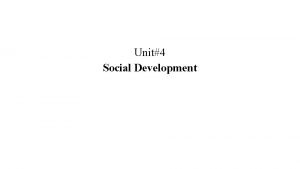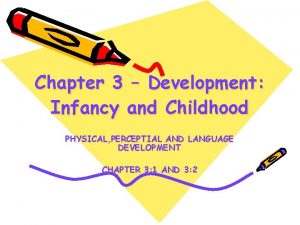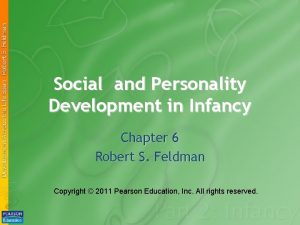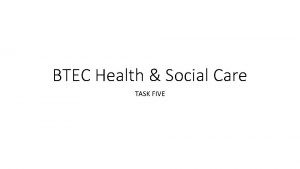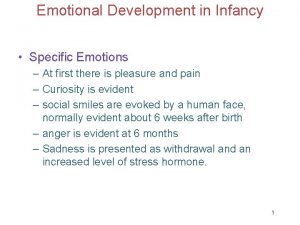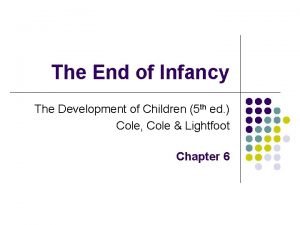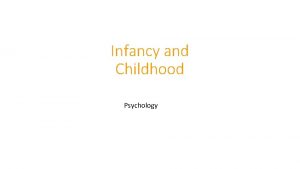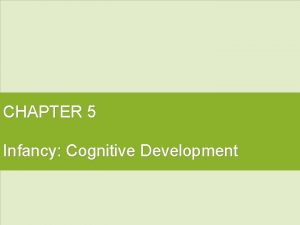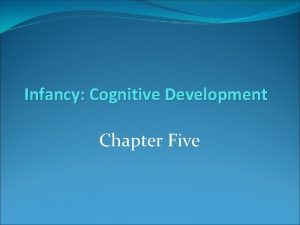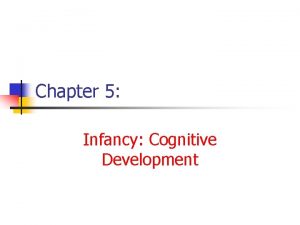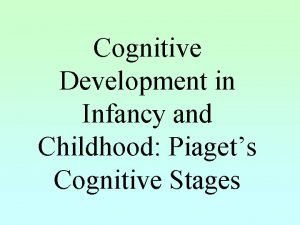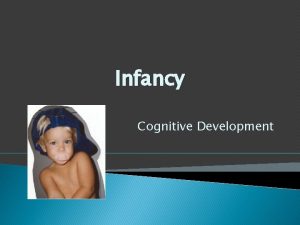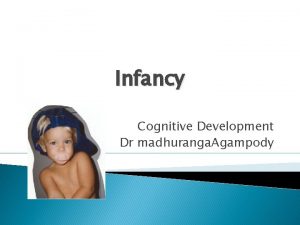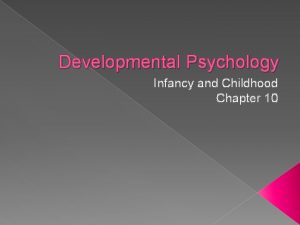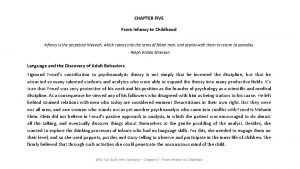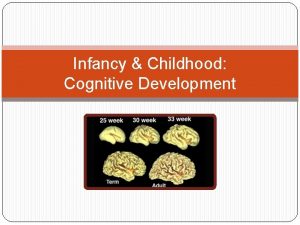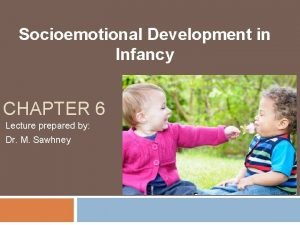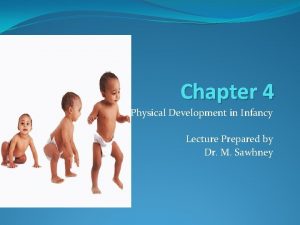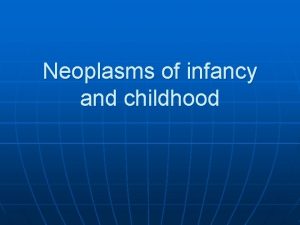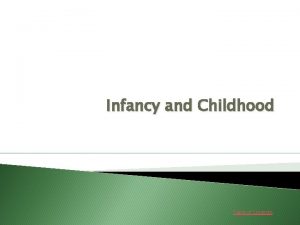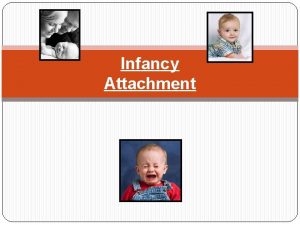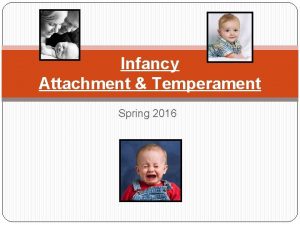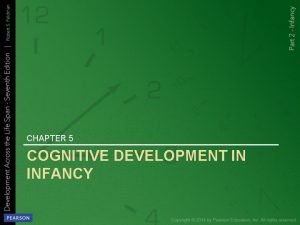CHAPTER 5 Cognitive Development in Infancy Lecture prepared





















- Slides: 21

CHAPTER 5 Cognitive Development in Infancy Lecture prepared by Dr. M. Sawhney

JEAN PIAGET

COGNITIVE PROCESSES Schemes Assimilation Accommodation Cognitive Equilibrium

SENSORIMOTOR STAGE (0 -2 YRS) Secondary Circular Reactions First Habits & primary Circular reactions Coordination of Secondary Circular Reactions

SENSORIMOTOR STAGE (0 -2 YRS) Internalization of Schemes http: //www. youtube. com/watch? v=v. Q 64 R 0 KKssc Tertiary Circulatory Reactions

OBJECT PERMANENCE Object permanence: Understanding that objects and events continue to exist: when they cannot directly be seen, heard, or touched No understanding under 4 months https: //www. youtube. com/ watch? v=NCd. LNu. P 7 OA 8

CRITICISM OF PIAGET’S SENSORIMOTOR STAGE The A-not B error Perceptual Development and Expectations Nature Vs. Nurture Issue

ATTENTION Attention Orienting and Investigative Process �Habituation & Dishabituation �Joint Attention

MEMORY Memory �Implicit memory �Explicit memory �Infantile amnesia �http: //www. youtub e. com/watch? v=e e 3 MFixi. Xwc

IMITATION If an adult smiles, will the baby respond with a smile? Imitative ability is not hardwired response http: //www. youtub e. com/watch? v=k 2 Ydk. Q 1 G 5 QI Deferred imitation

CONCEPT FORMATION AND CATEGORIZATION Concept Formation: � Grouping of similar objects, events, people or ideas �Perceptual Categorization �Conceptual Categorization �gradual shift from perceptual to conceptual categorization in toddlerhood

INDIVIDUAL DIFFERENCES AND ASSESSMENT Measures of infant development Predicting intelligence Gisell Test : Developmental quotient, score that combines subscores in 4 categories. Bayley Scales of Infant Development: Used to assess infant behaviour and predict later development Fagan Test of Infant Intelligence evaluates an infant’s ability to process information

LANGUAGE DEVELOPMENT Defining Language: A form of communication, spoken, written or signed, that is based on a system of symbols. It consists of the words used by a community and the rules for varying and combining them.

BASIC PROPERTIES OF LANGUAGE All human languages : spoken signed written Consists Infinite of : generativity Organizational rules

LANGUAGE RULE SYSTEMS Phonology: batter vs. badder Morphology: Happy, Unhappy, Happiness Syntax: “Today we are going to complete this chapter” “To chapter we this going are complete today” Semantics : The bicycle talked the boy into buying a candy bar. Pragmatics “The dog bite resulted in infection”

LANGUAGE DEVELOPMENT Recognizing language sounds Babbling and vocalizations other Crying Cooing Babbling Gestures Showing and pointing

STARTING TO TALK First words: � Receptive Vocabulary � Spoken Vocabulary Underextension Overextension Two-word utterances: telegraphic copies speech adult word pairings Gradually generalizes to grammatical rules

BIOLOGICAL INFLUENCES IN LANGUAGE DEVELOPMENT Regions involved language Broca’s area Wernicke’s area in

THEORIES OF LANGUAGE DEVELOPMENT Theories of Nativist Perspective: Children are biologically predisposed to learn a language Language Device � universal Acquisition grammar � infinite generativity

ENVIRONMENTAL INFLUENCES Behaviorist approach Interaction view - Children learn language in specific contexts Vocabulary development is linked to: Family’s socioeconomic status � Type of talk that parents direct to their children � � Child-directed speech: Higher pitch than normal, with simple words and sentences

INTERACTIONIST VIEW Interaction view - interaction between capacities and environmental influences inner social-interactionist view: emphasizes social skills and language experiences http: //www. youtube. com/watch? v=G 2 XBIk. HW 954
 Chapter 5 cognitive development in infancy and toddlerhood
Chapter 5 cognitive development in infancy and toddlerhood Module 47 infancy and childhood cognitive development
Module 47 infancy and childhood cognitive development Module 47 infancy and childhood cognitive development
Module 47 infancy and childhood cognitive development Social development in infancy
Social development in infancy Socioemotional development in infancy
Socioemotional development in infancy Chapter 7 human growth and development
Chapter 7 human growth and development Slidetodoc.com
Slidetodoc.com Slidetodoc.com
Slidetodoc.com Infancy and childhood physical development
Infancy and childhood physical development Personality development in infancy
Personality development in infancy Infant personality development
Infant personality development Health and social care intellectual development
Health and social care intellectual development New emotions that appear toward the second year
New emotions that appear toward the second year Module 46 infancy and childhood physical development
Module 46 infancy and childhood physical development Cognitive and non cognitive religious language
Cognitive and non cognitive religious language Psychology chapter 10 infancy and childhood
Psychology chapter 10 infancy and childhood Chapter 10 infancy and childhood review worksheet answers
Chapter 10 infancy and childhood review worksheet answers Chapter 10 infancy and childhood
Chapter 10 infancy and childhood 01:640:244 lecture notes - lecture 15: plat, idah, farad
01:640:244 lecture notes - lecture 15: plat, idah, farad Early childhood is __________ for language learning
Early childhood is __________ for language learning Infancy period
Infancy period Infancy and childhood psychology
Infancy and childhood psychology



